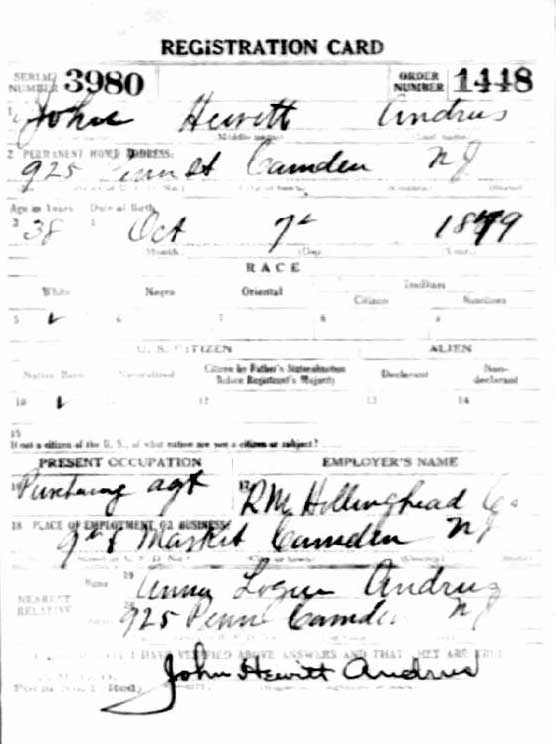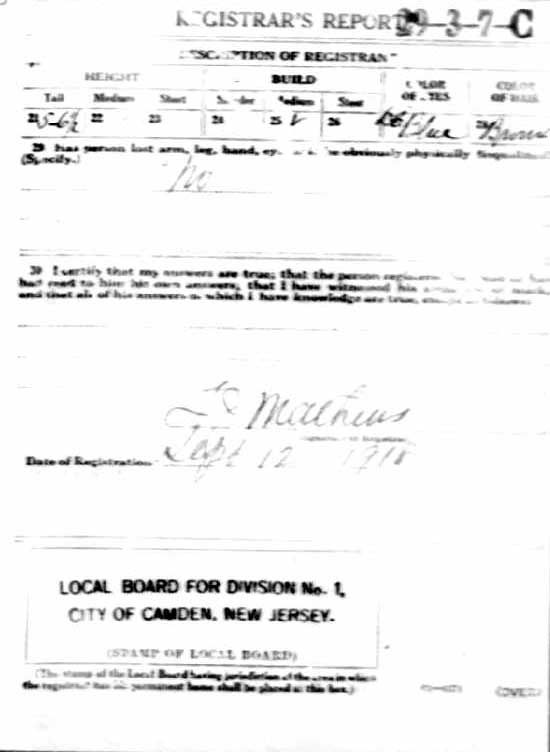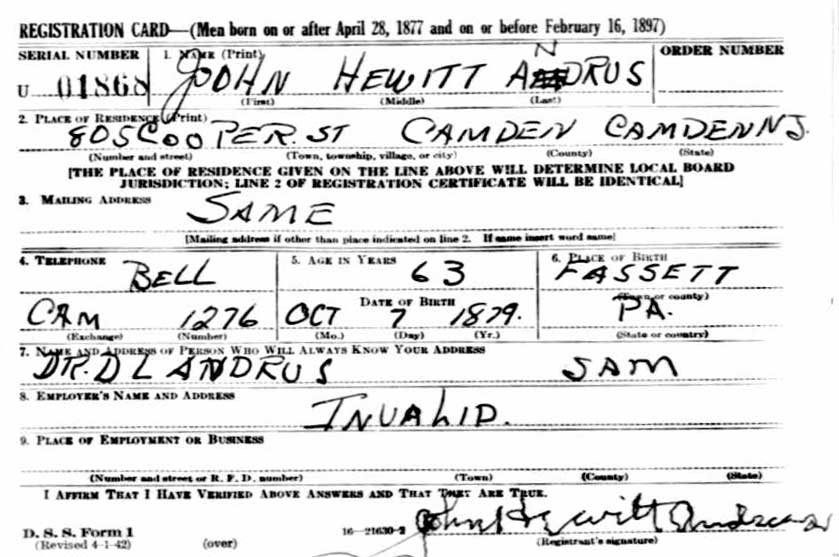|
John
Andrus' parents and siblings were living in Southport, New York when
the
Census was
taken in 1900. After
leaving the Army in 1902,
John
H.
Andrus came to Camden, New Jersey. His parents brought
the rest of the family to Camden by 1906. The
City Directory or that year shows them at 337
Warren
Avenue. The 1910 Census shows Seth Andrus had passed away.
His
widowed, sons
Chester, Tracy
and
Vernon, and sisters Ethel and Mary, at were then living at 812
Birch
Street.
John
H. Andrus married Anna Logue around 1905. Her father,
David
Logue, was a turmkey at the Camden County jail, and was
promoted to
warden the following year.. The 1906 City Directory
shows John H. Andrus living at 722
Grant
Street. A son,
David
L. Andrus,
was born in Camden, New Jersey in 1906. The 1910 Census and the 1914
Directory has the John H. Andrus family living with with
David
Logue and
family at 825
Penn
Street. By the summer of 1918 they had moved to the next
block,
taking up residence at
925 Penn
Street, which remained the family home into the
1930s.
John
Andrus was involved in a number of patriotic organizations. In
1917, with America involved in World War I, John Andrus returned
to service as an officer of the Camden Battalion of the Home
Guard.
After
America entered the war and the Eddystone
plant was evidently destroyed by incendiaries with such terrible
loss of
life, the Government deemed it necessary
that each community provide its own protection, so Home Guards were
organized subject to the call of the mayor
of the community in which these units were formed. When the
organization
call came hundreds of men
volunteered, many of them as old as sixty-five years.
Camden
set apart April 17, 19 17, as registration day.
Sheriff Joshua C.
Haines was chairman of the Home
Guards Committee of the Public Safety Committee and perfected an
organization for the registration. In
Camden 2,040 men enrolled in the thirteen wards and several
companies were
organized. Gloucester City,
Haddon Heights, Westmont and Haddonfield formed companies while
Merchantville formed a battalion.
The
companies drilled with broom sticks at first. Then
riot clubs were secured. Merchantville and Haddon Heights furnished
arms for
their companies by popular
subscription. The guards sought recognition from the State and
permission to
drill in armories, which was
granted about six months later. In the fall of 1917 the guards
became known
as the State Militia Reserve. They were not liable to duty outside
of the
community in which they were organized but could volunteer their
services to
the State in case of necessity.
In Camden, companies were organized in every ward in the city. In
fact there
were two companies in some wards, but the
slowness of the State department in equipping the men
caused them to lose heart after they drilled on the hot streets with
broom
sticks during the summer of 1917,
and the companies gradually dwindled away until there were but
enough men to
make up four full companies
throughout the city.
When the State finally recognized the Home Guard units Camden
organized a
battalion. The Camden
Battalion was formally recognized and accepted by the State on
November 17,
19 17. The battalion was
uniformed and equipped by the City of Camden. The first to command
this body
was Major Edward C.
Austermuhl, who later resigned to enter the service of the
Government. The board of officers then elected, and the Governor
commissioned Captain John H. Andrus as
major of the Camden Battalion.
Two hundred and seventy-seven officers and men comprised the command
of
Major Andrus with headquarters
in the Third Regiment Armory. The battalion took part in each of the
Liberty
Loan campaigns and in the drives
conducted by the Red Cross, Knights of Columbus, Young Men's
Christian
Association, et al. During the
influenza epidemic an Emergency Hospital was established at the
Armory of
Battery "B," in charge of a
committee from City Council. Unable to employ sufficient help, Mayor
Ellis
called on the State Militia
Reserve. While the hospital was in service one hundred and ten men
of the
Battalion were on duty twelve hours
each and performed every task assigned them most willingly. Aside
from their
hospital duties, men of the
Battalion were at various times assigned to go to private homes to
assist
the nurses in restraining delirious
patients.
On May 1, 1919, when anarchist and Bolshevist sympathizers had
prepared a
May Day celebration against
organized government, Mayor
Charles
Ellis called two companies of the Battalion to Third
Regiment Armory
where they
were held in reserve to aid the Police Department should the
situation
become alarming. Their services were not
needed, however, during the day.
On
September 17, 1919
Mayor ellis
called upon Major Andrus and the Home Guard to provide security
for the street car conductors and motormen after a highly
unpopular zone fare system was introduced.
John
H. Andrus worked for many years for the
R.M.
Hollingshed Corporation in Camden as a purchasing agent.
This firm, which manufactured the Whiz line of automotive
chemicals, may be best remembered for the
disastrous
fire that destroyed its factory at
North
9th Street and
Market
Street in 1940.
In
February od 1929 by an Act of Congress John H. Andrus was
awarded the Walter Reed Medal for his work
in fighting yellow fever.
Son
David L.
Andrus
graduated from
Camden
High School in 1925 and went on to become a doctor,
practicing in Camden for many years. In the 1930s
Dr. Andrus
set up residence and practice at 805
Cooper
Street. John
Hewitt Andrus moved from
Penn
Street to 805
Cooper
Street
during the 1930s. He died of heart disease in Philadelphia on May 1,
1942.
John
H. Andrus' younger brother,
Chester
J. Andrus, served for many years with the Camden Fire
Department.
|


